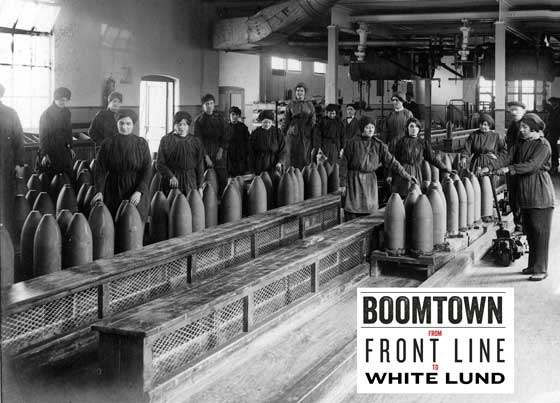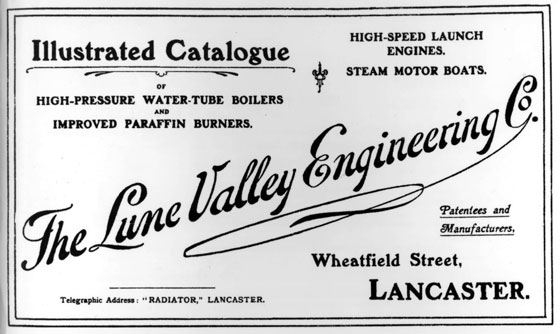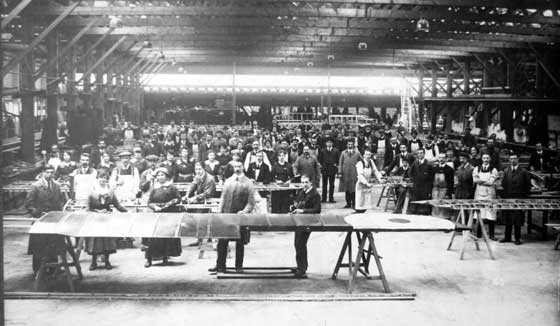The Great War Centenary
1917 - ExhibitionBoomtown - From
Front Line to White Lund
Lancaster’s war time production

As the British Army expanded in size - to more than 5 million men -
the need for military supplies, equipment, arms and munitions quickly
saw existing suppliers unable to cope with the demand. As the war
progressed more and more factories were built and many existing
businesses changed their output to meet the needs.
Lancaster was no different from many towns up and down the country. Two
massive factories were specially constructed to supply munitions and
existing works switched their production in support of the war effort.
National Projectile Factory
This new factory was built between Caton Road and the Midland Railway’s
line to Leeds via the Lune Valley. It was well served by all forms of
transport, including Lancaster’s canal (used for coal supplies) that
formed its northern boundary. Construction work started on 11th
September 1915 and production started on 5th March 1916 even though
building work was not finished until November.
Although Vickers Ltd of Barrow ran the enterprise, the local council
agreed to major improvements to that part of the town including laying a
new gas main, extending the bus route along Caton Road and even offering
discounted access for staff to the public baths and for team sports on
Giant Axe Field. The factory was designed to produce 6,000 6 inch,
3,500 9.2 inch and 6,000 60-pound shell cases a week. These were shipped
out and many found their way to their sister factory on White Lund. In
1917 the Projectile Factory took in guns for repair alongside its shell
case production.
Number 13 National Filling Factory
The Filling Factory site was well chosen with good communication routes
between to and from Lancaster and Morecambe. At the same time it was a
reasonable distance from both centres of population. The massive works,
at White Lund, feature in the next gallery.
Caton Engineering Works
The disused Wagon & Carriage Works on Caton Road had ceased production
in 1908. It had been used as an Internment Camp for German, Austrian and
Turkish ‘aliens’ in 1914-15, before being taken over for the war effort.
Caton Engineering Works was established, with much secrecy, by the
Vickers and Armstrong Companies to produce torpedoes. The works employed
large numbers of women including many doing precision tooling work, to
produce both the Mark VIII 18 inch torpedo and the Mark II 21 inch
torpedo. Production, at the end of 1917, rose to 22 torpedoes a week,
with the total produced by the end of the war being noted as 1,726.
Many of Lancaster’s existing firms answered the call, changing or
adapting production in their factories. Examples include:

The Lune Valley Engineering Company manufactured military field
cookers, not only for the British military, but also for other counties.
Each field cooker could provide enough stewed, boiled, baked or fried
food for 350 men at one time. These field cookers were used in
Gallipoli, Egypt, Mesopotamia, India and the Western Front in France and
Belgium.
William Goodacre and Sons Ltd produced a range of matting for
warship decks, field gun protectors and hospital ships at their Albion
Mills works. They also made various types of screening and camouflage
work at their looms.
Storeys Brothers bought in machinery to make shells and, by
February 1916, it was noted (and described as) ‘the munitions factory at
White Cross had been added to the list of Works controlled by the
Government’. In line with a number of businesses, Storey Brothers began
a weekly contribution to wives and dependents of men ‘at the front’.
Noting that foodstuffs were getting in short supply (before rationing
was introduced), the company introduced a yearly bonus to help offset
the rise in prices.
Williamsons of Lancaster continued to produce its key product,
linoleum. Although it did not become one of the Government controlled
factories its products were vital for the war effort. As their floor
coverings were easy to clean and disinfect it was in great demand from
hospitals, the Red Cross, convalescent homes and the like. This business
also paid an allowance to the families of their workmen serving in the
forces. They also started employing women in roles that had been
exclusively for men, as the workforce enlisted and were later
conscripted. In 1916, for example, of the 473 new staff taken on at
Williamsons just over 87% (414) were women. Their wages never matched
their male colleagues and, at 14 shillings (70p) a week, were around
half those of munitions girls at White Lund.
Waring and Gillow Ltd, Lancaster’s famous furniture business of
Gillows and Co dated back to the early 18th century. By the early years
of the 20th century it had merged with the Liverpool based company of
Waring. They produced a wide range of items for the war effort using the
full range of skills found across each department. This ranged from
standard joinery for packing crates, fine woodworking for aeroplane
wings and upholstery for tents, haversacks and even ‘serge tunics and
knickers for Indian troops’.
Waring and Gillow Ltd
Aircraft Work

Aircraft wing production at Waring & Gillows, Lancaster
Accession Number: LM74-86-2
Many components were manufactured for the DH9 aircraft.
Aeroplane wings
Aeroplane propellers
Centres
Tails
Struts
Engine beddings
Fuselage
Ailerons – the hinged wing flap that controlled the ‘roll’ of an
aeroplane
Waring and Gillow Ltd
General Work
Of this varied assortment of articles the firm were responsible for a
total output of 338,755
Tables
Ammunition Boxes
Bedsteads
Forms
Poles
Instrument Cases
Mule ammunition carriers
Nosebags
Machine gun cartridge belts
Water buckets
Pom-pom cartridge belts
Lewis gun ammunition carriers
Kit bags
Valises
Gun breech covers
Waterproof gun cotton bags
Bolsters
Rifle slings
Mosquito head covers
Mosquito net tents
Serge Tunics
Knickers for Indian Troops
Ordinary Tents
Gas mask haversacks
Rifle bolt covers
One-man tents
Munition workers caps
Haversacks
Horse water buckets
Horse rugs
Marquees
‘Housewives’ – a small fabric pouch for soldiers’ sewing essentials
(thimble, thread, spare buttons etc) to darn or repair uniforms
© Images are copyright, Trustees of the King's Own Royal Regiment Museum.
You must seek permission prior to
publication of any of our images.
Only a proportion of our collections
are on display at anyone time. Certain items are on loan for display
in other institutions. An appointment is required to consult any of
our collections which are held in store.




